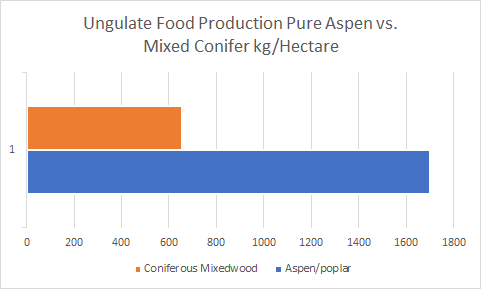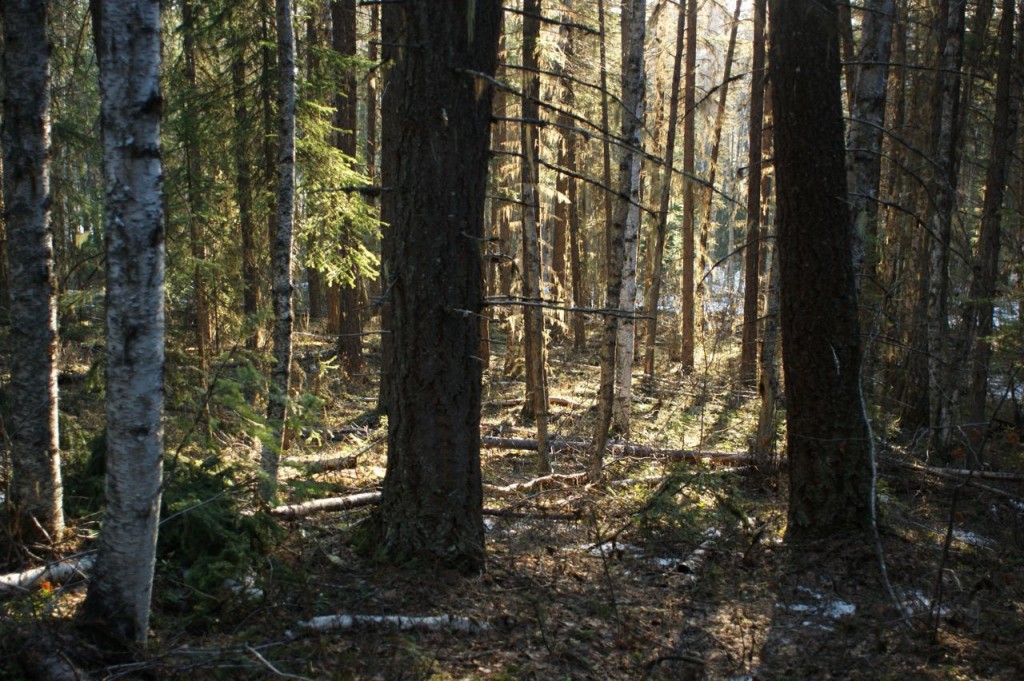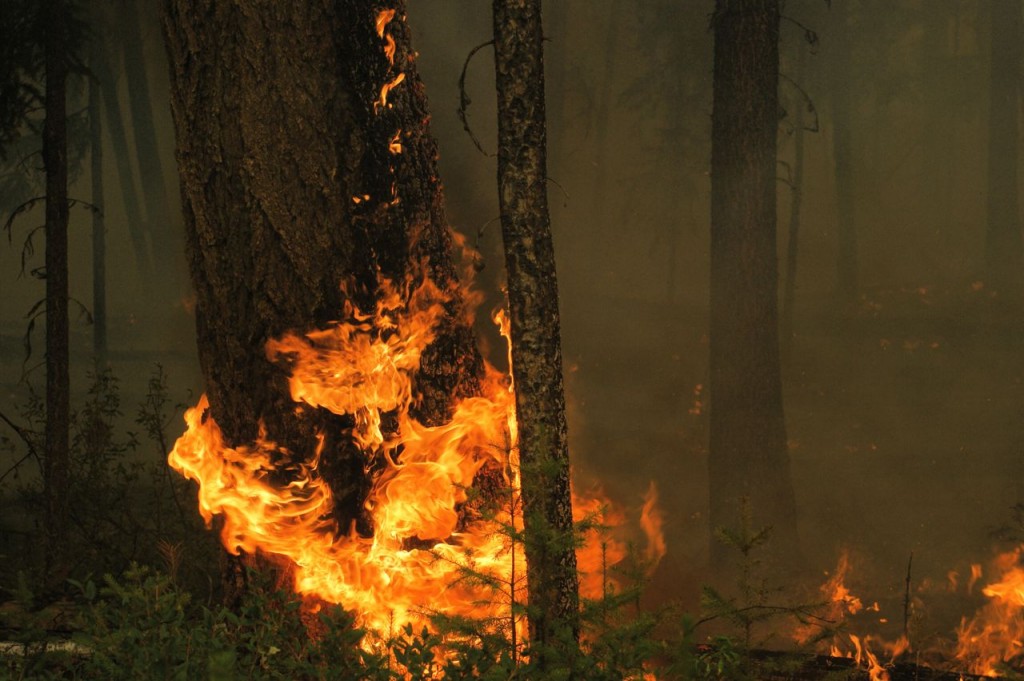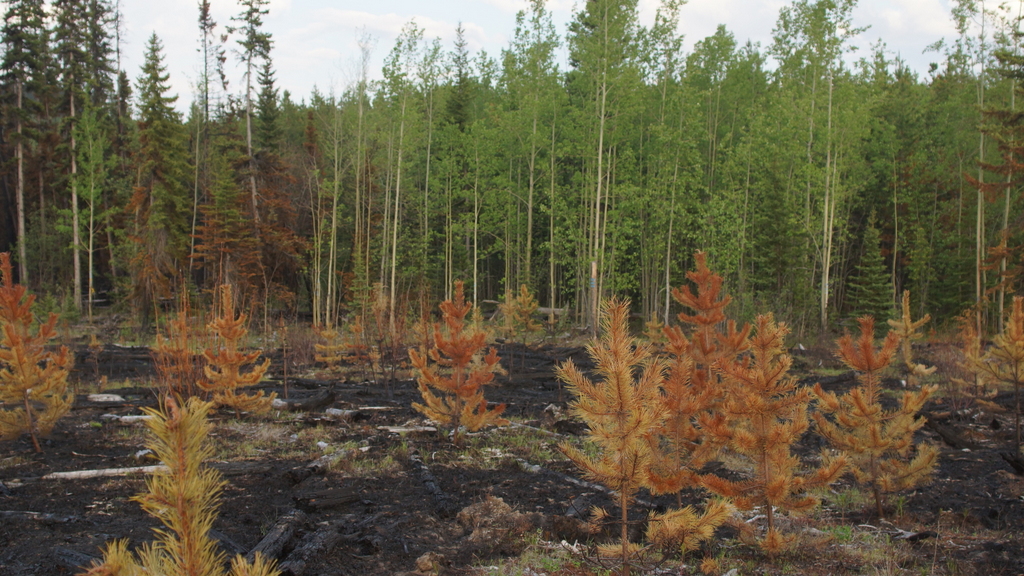- Importance to Wildlife
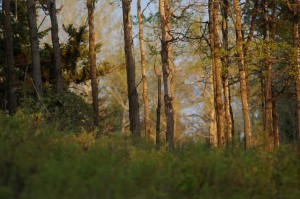
- Source of Soil Nutrients
- Improved Forest Health
- Reduced Forest Fire Intensity
- Greater Carbon Sequestration
Importance to Wildlife:
“Aspen ecosystems are extremely important to wildlife, providing habitat for at least 55 species of mammals and 135 species of birds.”- Suzanne W. Simard, Jean L. Heineman, W. Jean Mather, Donald L. Sachs, and Alan Vyse, Effects of Operational Brushing on Conifers and Plant Communities in the Southern Interior of British Columbia, Ministry of Forests, 2001, page 215.
“Aspen was the critical nesting tree…There was overwhelming selection for quaking aspen (Populus tremuloides); 95% of 1692 cavity nests were in aspen, which comprised only 15% of trees available.”- K. Martin, K. Aitken, and K. Wiebe, Nest Sites and Nest Webs For Cavity Nesting Communities in Interior British Columbia, Canada: Nest Characteristics and Niche Partitioning,” in: The Condor 106:5-19, 2004, page 5.
“Estimating Economic Carrying Capacity for an Ungulate Guild in Western Canada“- Gerald W. Kuzyk, N.L. Cool, E.W. Bork, C. Bampfylde, A. Franke, and R.J. Hudson, in The Open Conservation Biology Journal, 2009, 3, 24-35
“Aspen leaves, particularly those on suckers, are highly nutritious and provide summer food for moose, elk, and deer. Porcupines feed on aspen leaves and twigs in spring and summer and bark in winter, and beaver utilize it for food and dam-building materials. Aspen forests have about twice the density and diversity of insects as pure conifer stands, and consequently attract insectivores such as bats.”- Suzanne W. Simard, Jean L. Heineman, W. Jean Mather, Donald L. Sachs, and Alan Vyse, Effects of Operational Brushing on Conifers and Plant Communities in the Southern Interior of British Columbia,Ministry of Forests, 2001, page 215.
“Aspen stands can contain up to ten times (1000%) more forage than conifer stands, and the diverse grasses, forbs, and shrubs that grow in these areas are a valuable resource for livestock.” Olivia Salmon, Chad Reid, Darren McAvoy, Utah State University Forest Grazing: Managing your Land for Trees, Forage, and Livestock
“Seral aspen communities averaging 162 square feet per acre (37.2 m2 per ha) total tree basal area, 15% of which was conifers, produced 743 pounds per acre (833 kg per ha) of undergrowth; those with 183 square feet per acre (42 m2 per ha) basal area. 34% conifers, produced 422 pounds per acre (473 kg per ha); and those 234 square feet per acre (53.7 mZ per ha) basal area, 68% conifers, produced only 213 pounds per acre (239 kg per ha) of undergrowth. Stable aspen communities in the same locality with an average basal area of 187 square feet per acre (42.9 m2 per ha), all of which was aspen, produced 1,471 pounds per acre (1 649 kg per ha) of undergrowth.” Muggler, Forage, Chapter 5 of Aspen: Ecology and Management in the Western United States, ed. by Norbert Debyle, US Forest Service, 1985
Based on the average AUM of forest types on page 141, Aspen dominated forests supported 230% more cattle than conifer: Range Plant Community Types and Carrying Capacity for the Montane Sub-region of Alberta– Michael G. WIlloughby, Michael J. Alexande and Barry W. Adams, Sustainable Resource Development, Public Lands Division, Government of Alberta, 2005
Source of Soil Nutrients
“Even though the alder is competing for site resources and has reduced light levels, its presence may provide an additional source of nitrogen. Height and diameter results suggest that spruce growth is not compromised by the alder.”- G.J. Harper, L.J. Herring, and W.J. Hays-Byl, Conifer and Vegetation Response in the BWBSmw1 12 Years after mechanical and Herbicide Site Preparation, Ministry of Forests, 1997, page 18.
“The elimination of shrubs and broad-leaved trees through herbicide application can alter synergistic relationships, such as the belowground mycorrhizal processes provided by certain shrub species,” “The Forgotten Stage of Forest Succession: EarlySuccessional Ecosystems on Forest Sites” Mark E. Swanson Jerry F. Franklin Robert L. Beschta Charles M. Crisafulli Dominick A. DellaSala, in Biological Sciences Faculty Publications, University of Montana, 2011, 278
“The leaf litter generated from a relatively small amount of aspen in conifer dominated stands will significantly slow the development of the feathermoss blanket and the development of a mor humus type in these stands. This will likely maintain soils with higher soil temperature and nutrient cycling compared to soils covered with a blanket of feathermosses. These different soil conditions could also have a significant effect on present and future site productivity.” Impact of Aspen Litter on Forest Floor Development in Conifer Dominated Stands, Centre for Enhanced Forest Management, Department of Renewable Resources, University of Alberta, 2007
“Aspen provides both short- and long-term nutritional benefits to forest sites. It takes up large quantities of nutrients and stores them in woody tissues, thus retaining nutrients within the ecosystem. It is particularly efficient at retaining calcium, sulfur, and zinc, especially in the bark, which has photosynthetic capability. Aspen foliage is shed annually, but it decomposes rapidly and tends to be efficiently cycled within the forest ecosystem. A modelling study based on data collected in boreal forests of northeastern British Columbia suggests that mixed forests of aspen and spruce will produce greater biomass over several rotations that pure spruce forests of the same density.” Suzanne W. Simard, Jean L. Heineman, W. Jean Mather, Donald L. Sachs, and Alan Vyse, Effects of Operational Brushing on Conifers and Plant Communities in the Southern Interior of British Columbia,Ministry of Forests, 2001, page 235.
“Birch accumulates high levels of nutrients within leaves and woody tissues compared with neighbouring conifers, which helps maintain ecosystem productivity when birch litter is cycled. A recent modelling study predicted eventual losses in overall stand productivity if birch were completely eliminated in favour of conifers.” Suzanne W. Simard, Jean L. Heineman, W. Jean Mather, Donald L. Sachs, and Alan Vyse, Effects of Operational Brushing on Conifers and Plant Communities in the Southern Interior of British Columbia,Ministry of Forests, 2001, page 304.
“The aspen cycle nutrients that the conifers eventually benefit from but what were’ deciding is: ‘We’re going to take that out. We don’t need that. We are going to short circuit succession and we’re going to go straight to the conifers. But the broadleaves have a role in early succession. Most of these broadleaves are very rich in nutrients. They have high photosynthesis rates and are high in nitrogen. When their litter falls to the forest floor in the fall their nutrients are cycled back into the soil for the conifers to pick up.”- Dr. Suzanne Simard, personal conversation, 2011.
Improved Forest Health
“In spite of its ability to compete for resources, aspen also benefits conifers in several ways. It takes up large amounts of nutrients, especially calcium, at an early age and retains them within the ecosystem. It may also slow the spread of root disease in mixed stands because it is immune to Phellinus weirii and more resistant to Armillaria ostoyae than most conifers. Mature aspen canopies also reduce frost damage to seedlings in the understorey by restricting radiative heat loss during the night and imporving air temperatures at seedling height. Because of its sucker-oritin communal root system, aspen is mechanically stable, and its presence may increase resistance of neighbouring conifers to windthrow.”- Suzanne W. Simard, Jean L. Heineman, W. Jean Mather, Donald L. Sachs, and Alan Vyse, Effects of Operational Brushing on Conifers and Plant Communities in the Southern Interior of British Columbia,Ministry of Forests, 2001, page 215.
“The incorporation or existence of broadleaf species in a stand may be desirable for a number of reasons, including broadleaf timber production, biodiversity, increased resiliency to climate change, wildlife habitat, nurse crops for conifers, reducing the risk of fire and forest health problems, and potentially increasing yield.” Tim Sheldon and Jim Snetsinger, Memorandum to Regional Executive Directors and District Managers, Ministry of Forests, May 1, 2008.
“One hypothesis about why mixed stands are often preferable over pure stands is that individual trees of the same species have less root and crown contact in mixed stands than in pure stands, which reduces the possibility of disease transmission. The other general principle is that mixed stands are better able to survive if there is an outbreak of one forest pest specific to only one of the tree species in the stand. Although it has not been fully documented for birch–conifer mixed stands in British Columbia, there are suggestions that some tree species in mixed stands may benefit from damage to other tree species in the stand. In principle, this could be one way that mixed stands provide the best opportunity to sustain woody biomass productivity, as well as overall forest health and biodiversity values.” Paper Birch Manager’s Handbook for British Columbia, BC Ministry of Forests, 1997.
“In many forests Douglas fir is the preferred species and paper birch–a fast-growing tree that can shade the slower-growing firs for decades–is considered a weed. But Simard says the birches may be nurturing the firs. These species that we think of as weeds are serving as critical links, and once we sever these links, we affect the stability of those ecosystems. Our practices are still based on the notion that forests act like gardens, and we should weed out what we don’t want. But forests are far more complex than that, and we need to maintain this diversity.”- Carl Zimmer, The Web Below, Discover Magazine, November 1997.
Reduced Forest Fire Intensity:
“Broadleaves are less flammable than conifers. If you have breaks of broadleaves across the landscape they slow the rate of the spread of the fire.”- Dr. Suzanne Simard, UBC Forest Science Professor, personal conversation, 2011.
“Its fair to say if you have tree species A that doesn’t burn very much and tree species B that usually burns a lot- you’re going to have less fire altogether if you don’t separate them spatially.” Dr. Steve Cumming, Canada Research Chair in Boreal Ecosystems Modelling, personal conversation, 2010
“[Monocultures of conifers are] going to increase the risk of burning at least for a couple of decades relative to if you had a mixed stand of pine and aspen.”- Dr. Steve Cumming, Canada Research Chair in Boreal Ecosystems Modelling, personal conversation, 2010.
“I think balance is important. To suppress a relatively fire-resistant species you are potentially creating a mono-fueltype. In my opinion you have to have a mosaic of species. One species will be its own buffer.” Steve Richburg- Forest Protection Officer, Quesnel, Ministry of Forests, personal conversation, 2011.
“The more mosaic of uneven age groups of the species out there- and a big factor would be the aspen in this country [since] it does not have that crown-fire capability- if you could have that in there it would certainly be a benefit. No doubt about it.” – Steve Richburg, Forest Protection Officer, Quesnel, Ministry of Forests, personal conversation, 2011.
“We saw plantations lost [In the Pelican Lake area] because of fuel build-up adjacent to it. Many of the trees were destroyed. We had a major setback out there. Depending on the width of the aspen it would have made a difference. It’s a no brainer that an aspen stand next to or along the perimeter of the plantation [would have made a difference]. [We should] encourage the aspen growth.”- Steve Richburg, Forest Protection Officer, Quesnel, Ministry of Forests, personal conversation, 2011.
Studies Showing Fire Resistance of Aspen and Broadleaves
Girardin_et_al-2013-New_Phytologist
Greater Carbon Sequestration
“Severe burning of organic soils shifted tree dominance from slow-growing black spruce to fast-growing deciduous broadleaf trees, resulting in a net increase in carbon storage by a factor of 5 over the disturbance cycle. Reduced fire activity in future deciduous-dominated boreal forests could increase the tenure of this carbon on the landscape, thereby mitigating the feedback to climate warming.” Carbon Loss From Boreal Forest Wildfires Offset by
Increased Dominance of Deciduous Trees- Science 372, 280–283 (2021)
An aspen tree stores 45% more carbon than Lodgepole Pine and 25% more than interior spruce- “BC Forest Carbon Offset Investment Opportunities”
“Forest changes have nudged Europe’s summer temperatures up by 0.12 C since 1750, largely because many nations have planted conifers such as pines and spruce whose dark colour traps the sun’s heat, the scientists said. Lighter-coloured broad-leafed trees, such as oak or birch, reflect more sunlight back into space but have lost ground to fast-growing conifers, used for everything from building materials to pulp.”- Conifer Forest Expansion Blamed for boosting Global Warming– CBC News, February 4, 2016
“Aspen abundance was linked with higher aboveground tree productivity, higher aboveground living biomass and higher soil heterotrophic respiration, indicating that aspen acts as a key driver of ecosystem C storage and fluxes in these natural forest ecosystems, more so than species richness.” “The Influence of Boreal Tree Species Mixtures on Ecosystem Carbon Storage and Fluxes” Forest Ecology and Management 354, 2015

